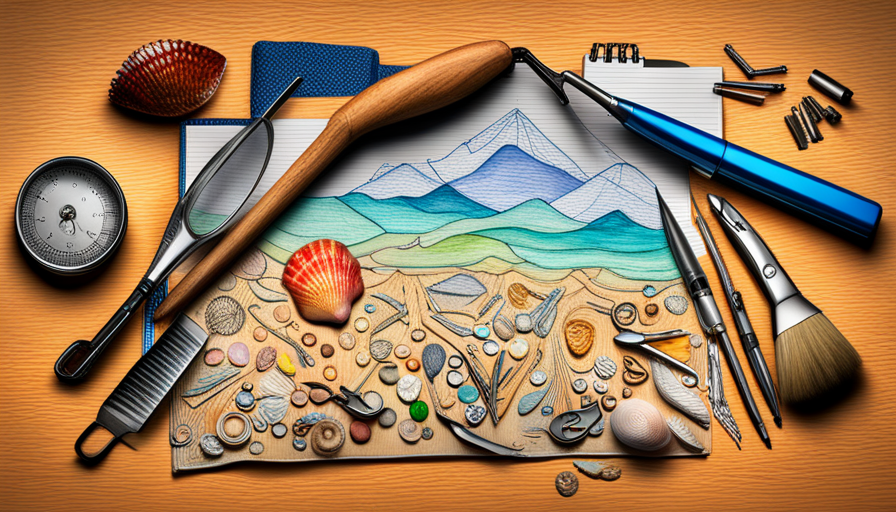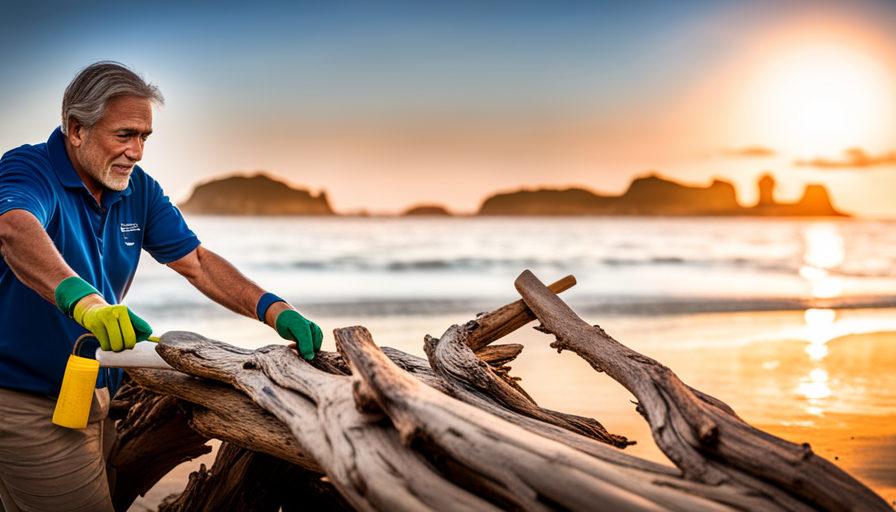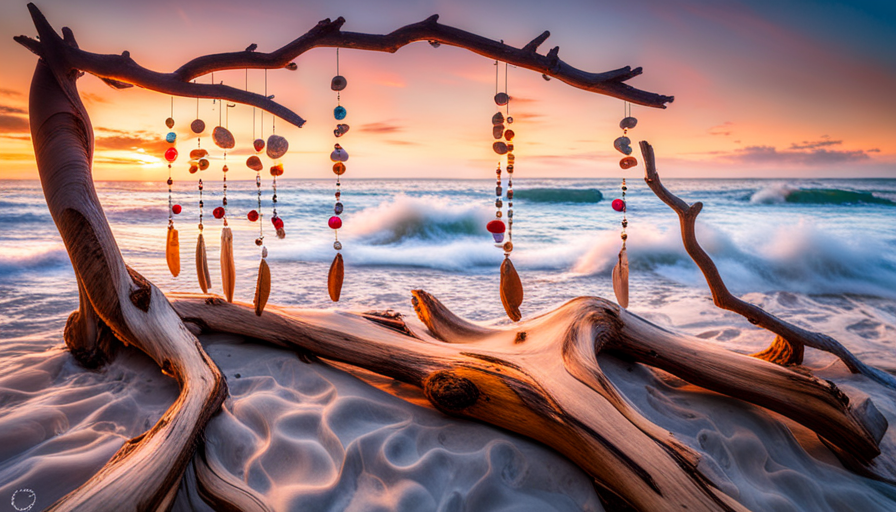Are you a beachcomber, constantly on the lookout for hidden treasures along the shoreline? Well, hold onto your sun hats, because we’ve got a driftwood collecting guide that will blow your flip-flops off!
We’ve compiled the top seven tips to help you become the ultimate driftwood hunter, uncovering the most stunning and unique pieces nature has to offer.
Imagine strolling along pristine sandy beaches, the warm sun kissing your skin, as you uncover the most exquisite pieces of driftwood. With these tips, you’ll know exactly which beaches to choose, what to look for, and the best time to find those hidden gems. Equipped with the right tools and armed with knowledge on how to spot decay or damage, you’ll be able to select the perfect pieces for your collection.
But the adventure doesn’t stop there! We’ll also show you how to clean, preserve, and get creative with your driftwood finds.
So, get ready to embark on a driftwood collecting journey that will set you free and let your imagination soar. Let’s dive in and make your beachcombing dreams come true!
Key Takeaways
- Choose beaches with a mix of sand and rocky areas for better chances of finding driftwood.
- Beachcombing during low tide, especially in the early morning, is the best time for collecting driftwood.
- Having the right tools such as gloves, a net, and a metal detector is essential for successful beachcombing.
– When collecting driftwood, check for signs of decay or damage to ensure stability and suitability for collection.
Choose the Right Beaches for Driftwood Hunting

To find the best driftwood treasures, you’ll want to head to beaches that are known for their abundance of this natural beauty.
The first thing to consider is the best time to go beachcombing for driftwood. Ideally, you should plan your excursion during low tide. This is when more of the beach is exposed, giving you a better chance of discovering hidden gems washed ashore.
In addition to timing, beach conditions play a crucial role in your driftwood hunting success. Look for beaches that have a mix of sand and rocky areas. These types of beaches are more likely to have a variety of driftwood pieces, as the rocks trap the wood and prevent it from washing back into the sea.
Furthermore, consider the weather conditions before heading out. Stormy weather can bring in a fresh supply of driftwood, while calm days may have less to offer. Keep an eye out for recent storms or high winds, as they can create prime conditions for driftwood to wash ashore.
Remember, the key to a successful driftwood hunting adventure is choosing the right beach. By planning your visit during low tide and considering the beach conditions, you’ll increase your chances of finding the most beautiful and unique pieces of driftwood. So grab your beachcombing gear and get ready for an exciting treasure hunt!
Know What to Look For

When you stroll along the sandy shore, keep your eyes peeled for hidden treasures that’ll transport your soul to the whispers of the sea. As a beachcomber, it’s important to know what to look for when it comes to driftwood. Different types of driftwood have unique characteristics that make them desirable for various purposes.
To identify driftwood, pay attention to its shape, size, and texture. Driftwood can come in various forms, such as branches, logs, or even whole trees. Look for pieces that’re weathered and worn, with smooth edges and a silvery-gray color. These’re often the most beautiful and sought-after pieces.
Once you’ve collected your driftwood, it’s crucial to properly store it to prevent decay. Start by cleaning the wood with a brush to remove any sand or debris. Then, let it dry completely to prevent the growth of mold or fungi.
You can store the driftwood indoors or outdoors, depending on your preference. If you choose to store it outside, make sure it’s protected from direct sunlight and excessive moisture. If you prefer to store it indoors, keep it in a well-ventilated area away from heat sources.
By following these tips, you can ensure that your driftwood remains in pristine condition for years to come and continues to evoke the freedom and beauty of the sea.
Timing is Everything

As you stroll along the sandy shore, keep in mind that timing is everything for finding the perfect piece of driftwood to add to your collection. Beachcombing techniques can greatly increase your chances of finding the most unique and beautiful driftwood pieces. Here are some tips to help you make the most out of your beachcombing experience:
- Be an early bird: The best time of day for beachcombing is early in the morning when the tide is low. This is when the ocean has pushed ashore the most treasures for you to discover. Arriving early also means you’ll have the beach all to yourself, allowing you the freedom to explore without any distractions.
- Pay attention to the tides: Timing your beachcombing adventure with the tides is crucial. Low tide exposes more of the beach, giving you access to areas that are usually underwater. This is where you’ll find the hidden gems that have been washed ashore.
- Watch for stormy weather: After a storm, the ocean often brings in an abundance of driftwood. The rough waves and strong winds can wash up larger and more interesting pieces. Keep an eye out for these opportunities and plan your beachcombing trip accordingly.
By following these beachcombing techniques and knowing the best time of day for beachcombing, you’ll increase your chances of finding the most exquisite driftwood pieces. So grab your hat, sunscreen, and a sense of adventure, and head to the beach to start your search for the perfect addition to your collection.
Bring the Right Tools

Equipped with the right tools, beachcombers can enhance their driftwood collection and unearth hidden treasures along the sandy shore. When it comes to beachcombing, having the appropriate tools can make all the difference.
One essential tool is a sturdy pair of gloves. Not only will gloves protect your hands from sharp objects and splinters, but they’ll also provide a better grip when handling larger pieces of driftwood.
Another handy tool to have is a long-handled net. This’ll allow you to easily scoop up smaller items like shells, sea glass, and other treasures that may be hiding in the sand.
In addition to gloves and a net, a metal detector can be a game-changer for beachcombers. This tool can help you find hidden treasures buried beneath the surface. Simply sweep the detector over the sand and listen for the telltale beep that indicates something valuable may be nearby. A small shovel or trowel is also useful for digging up buried items.
When beachcombing, it’s important to have a bag or bucket to store your finds. This’ll keep them safe and prevent them from getting lost or damaged. Additionally, bring a camera or smartphone to capture the beauty of your discoveries. Whether it’s a unique piece of driftwood or a stunning seashell, having a way to document your findings will allow you to cherish the memories long after your beachcombing adventure is over.
By utilizing these beachcombing techniques and bringing the right tools, you can maximize your driftwood collection and uncover hidden treasures along the shoreline. So, grab your gloves, net, metal detector, shovel, and bag, and head out to the beach for an exciting and rewarding beachcombing experience.
Check for Signs of Decay or Damage

Before venturing out to the beach, it’s crucial to check for signs of decay or damage, like a rotting log that resembles a soggy sponge, as these can be indications of unsuitable driftwood for collecting.
Identifying potential hazards is essential to ensure your safety and enjoyment while beachcombing. When examining driftwood, look for signs of decay such as soft spots, holes, or crumbling wood. These can be potential hazards and may compromise the stability of the driftwood. It’s important to avoid collecting driftwood that is severely damaged or falling apart, as it may not withstand the weight of display items or storage.
Once you have selected driftwood that is sturdy and in good condition, it’s crucial to consider proper storage and display options. After cleaning and drying the driftwood, you can choose to store it in a cool and dry place to prevent further decay. If you plan on displaying your collection, consider using shelves, hooks, or even creating a driftwood sculpture. The options are endless, and it’s important to let your creativity shine.
Just remember to avoid placing heavy objects on delicate pieces of driftwood to prevent damage. By following these tips, you can ensure a successful and enjoyable beachcombing experience while keeping your driftwood collection safe and beautiful.
Clean and Preserve Your Driftwood

To ensure your driftwood stays in pristine condition, it’s important that you take the time to clean and preserve it properly. Cleaning your driftwood not only enhances its natural beauty but also helps to remove any dirt, debris, or potential pests that may have hitched a ride. Here are some top tips to help you clean and preserve your driftwood:
- Start by rinsing your driftwood with fresh water to remove any loose dirt or sand. Avoid using soap or chemicals as they can strip away the natural patina.
- Next, fill a large container with a mixture of water and bleach. Soak your driftwood in this solution for 24-48 hours, depending on the size and condition of the wood. This helps to kill any bacteria or insects and helps to lighten the driftwood’s color.
- After soaking, rinse the driftwood thoroughly with fresh water and let it dry in a well-ventilated area. Avoid direct sunlight as it can cause the wood to crack or fade.
- Once dry, you can further preserve your driftwood by applying a clear sealant or wood preserver. This helps to protect the wood from moisture and adds a glossy finish.
By following these steps, you can ensure that your driftwood is clean and ready for use in various driftwood art projects or DIY driftwood furniture. Let your imagination run wild and create unique pieces that reflect your personal style and love for the beach. Enjoy the freedom that comes with creating beautiful and functional items from nature’s treasure!
Get Creative with Your Driftwood Finds

Let your imagination run wild and unleash your inner artist by transforming your driftwood finds into stunning and unique pieces of beach-inspired decor. There are endless driftwood art projects and beachcombing crafts that you can create with your collection.
One idea is to make a driftwood mobile by hanging different lengths and shapes of driftwood from a branch or piece of driftwood. You can add seashells, sea glass, and other beach treasures to make it even more beautiful.
Another fun project is to create a driftwood sculpture. Use your driftwood pieces to build a small or large sculpture, such as a fish, bird, or abstract shape. You can use glue or nails to secure the pieces together.
If you’re feeling extra creative, try making a driftwood picture frame. Use a sturdy piece of driftwood as the base and attach smaller pieces around it to create a unique frame for your favorite beach photo.
Remember, the possibilities are endless when it comes to driftwood art projects and beachcombing crafts. Let your creativity shine and enjoy the freedom of turning your driftwood finds into beautiful works of art.
Frequently Asked Questions
How do I know if a beach is suitable for driftwood hunting?
To find a beach suitable for driftwood hunting, check the beach conditions. Look for rocky or sandy areas with strong waves and tides. These conditions increase the chance of driftwood availability. Enjoy the freedom to explore!
What are some common signs of decay or damage to look for in driftwood?
You stumble upon a piece of driftwood that looks like it’s seen better days. How can you repurpose or upcycle damaged driftwood? Well, you can turn it into a unique wall hanging or a rustic table centerpiece. But beware, using decayed driftwood for crafts or home decor can be dangerous. It can release harmful chemicals or even collapse, so make sure to inspect it thoroughly before getting creative. Now, let’s dive into the top tips for beachcombers!
What are the best tools to bring for collecting driftwood?
The best tools for collecting driftwood include a sturdy backpack, gloves, and a long-handled net. When displaying driftwood in your home, consider using it as wall art, creating a centerpiece, or making a unique table. Look for different types of driftwood, like gnarled branches or smooth, weathered logs.
Are there any specific cleaning techniques or products recommended for preserving driftwood?
To preserve driftwood, start by gently scrubbing it with a soft brush and warm soapy water. Then, rinse it thoroughly and let it dry in the sun. For added protection, apply a clear varnish or wood sealant.
Can you provide some examples or ideas for creative projects using driftwood?
Create stunning driftwood art installations by arranging driftwood pieces into sculptures or hanging them on walls. Use driftwood to make unique picture frames by attaching the wood around the edges for a rustic and coastal touch.
Conclusion
So there you have it, my friend. You’ve now embarked on a journey to become a skilled beachcomber, a true collector of driftwood. By following these top tips, you’ll be able to choose the right beaches, know what to look for, and bring the right tools.
Remember to check for signs of decay or damage, clean and preserve your finds, and let your creativity soar as you transform your driftwood into beautiful creations.
Happy beachcombing!
